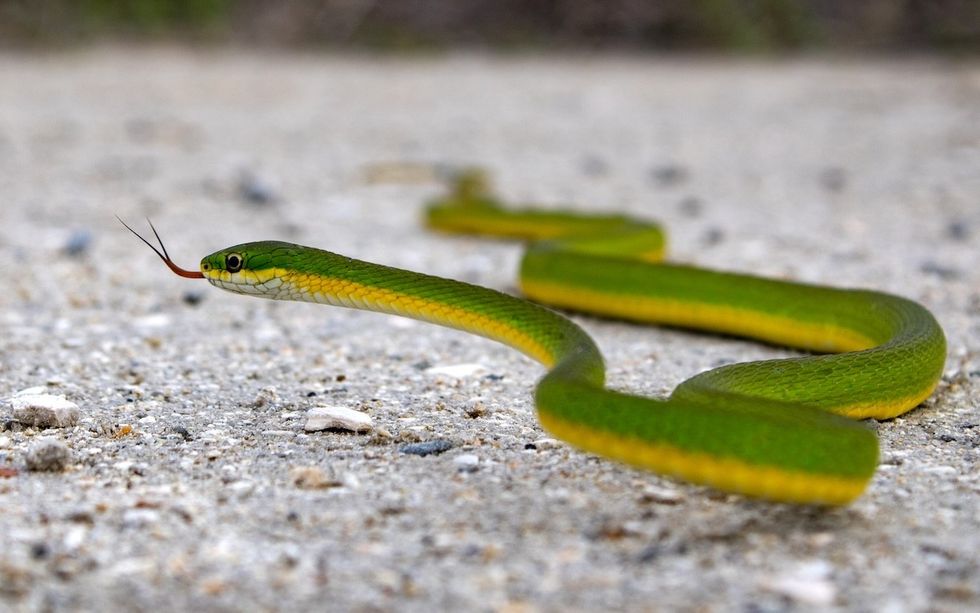With snakes, no hiding place is off limits. These sneaky creatures will find a way to take up residence in your toilet, garage, and, believe it or not, your car engine—even if it means scaling a tall fence or wall. However, some reptiles are more skilled climbers than others. As we approach warmer weather, here are three climbing snake species to look out for. Plus, how to snake-proof your home.
RELATED: 4 Scents That Attract Snakes to Your Yard, Experts Say.
1. Rough greensnakes
Shutterstock
Rough greensnakes have long, slender bodies with round eyes, raised scales, and a “cream to yellow” belly, according to The Florida Museum of Natural History. Their tails are “extremely long and thin,” and most adults reach up to 33 inches in total length. Fortunately, for humans, they’re nonvenomous. However, they love to climb and lurk in trees.
Per the museum, rough greensnakes are “fairly abundant” along the Atlantic coast. They “primarily live in trees and prefer densely leafed trees and shrubs, often at the edges of fields and around ponds.”
Experts say rough greensnakes are more scared of us than we are of them, and they shelter under tree foliage as a defense mechanism.
2. Rat snakes

There are several subspecies of rat snakes, but the most common climbers include black rat snakes and yellow rat snakes.
According to a Georgia Public Broadcasting (GPB) news segment, black rat snakes are “notoriously good climbers” and can “scale all sorts of surfaces.” However, yellow rat snakes, which thrive in coastal environments, are “among the strongest.” Both rat snake species are nonvenomous.
“Rat snakes are good at climbing up the sides of trees and things like that where there’s irregularities that they can catch their bodies on,” Jeff Beane, a collections manager for herpetology at the North Carolina Museum of Natural Sciences, told The News & Observer.
As for why they prefer being up high rather than on the ground, it comes down to diet. Rat snakes primarily eat bird eggs for fuel.
“There’s a running joke that says if you find a snake somewhere and you’re like, ‘How in the world did it get there,’ it’s probably a rat snake,” added Falyn Owens, an extension biologist at the North Carolina Wildlife Resources Commission.
3. Black racer snakes

iStock
Black racer snakes are “nimble climbers, especially when they are young,” warned the GPB.
Juvenile black racer snakes have lanky, gray bodies with “irregular reddish-brown blotches,” per the University of Florida Department of Wildlife Ecology & Conservation. They have smooth scales and round pupils. Their blotches eventually fade, leaving adult race snakes with solid black bodies and white throats.
How to snake-proof your home:

iStock
Unfortunately, maintaining a snake-proof home can feel like a full-time job, especially for folks who live in hot, tropical climates.
“The best way to keep snakes away is to make your yard as inhospitable as possible. Eliminate their food source, like rats and mice. Keep your grass short and remove any underbrush. Clear away ground cover like pine straw or leaves, and eliminate hiding spots like wood piles or debris,” advised the GPB.
Additionally, certain plants, including marigolds and basil, can repel snakes because of their aroma. The same goes for citrus fruits.
“One of the most commonly used snake-repelling scents is citrus,” Jennifer Mecham, a snake expert and writer for Reptiles Blog, previously told Best Life. “Citrus fruits like lemons, oranges, and grapefruits contain a chemical called limonene, which is a natural snake repellent. Just place a few slices of citrus fruit around your home, or even rub the peel on the outside of your door and windows.”
Content shared from bestlifeonline.com.

